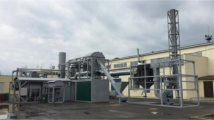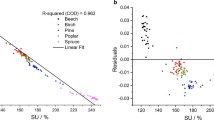Abstract
This article presents a method for fractionating and separating phenolic compounds from liquid pyrolysis products of lignocellulosic biomass by a three-stage method, in which up to 30% of phenolic compounds can be extracted. The composition of the phenol-substituting fraction was analyzed by the gas chromatography–mass spectrometry (GCMS) method. The isolated phenolic compounds were used in the synthesis of phenol–formaldehyde resins as a phenol-substituting fraction, with the replacement of 40% of the synthetic phenol in the recipe. Various molar ratios of phenol/formaldehyde and phenol/sodium hydroxide in the resin synthesis recipe were considered, as well as their influence on the strength of the adhesive joint and the proportion of free formaldehyde in the finished modified resin. The results of the studies showed that the optimal molar ratio of phenol/formaldehyde is 1:1.98, with a tensile strength of 1.63 MPa and a free formaldehyde fraction of 0.10% in the resin. The phenol/sodium hydroxide molar ratios considered in this paper did not show an optimal molar ratio, but a tendency to reduce the free formaldehyde content in the resin with a decrease in the introduction of an alkaline catalyst into the resin recipe was revealed, while the strength of the adhesive joint remains normal.





Similar content being viewed by others
References
Kondratiev VP, Kondrashchenko VI (2004) Synthetic adhesives for wood materials. Moscow: Nauchny mir. 520 p (in Russian)
Uvarov IP, Gordon LV (1962) Wood resins. (synthetic products based on wood chemical phenols). Moscow: Goslesbumizdat. 84 p. (in Russian)
Gardziella A, Pilato LA, Knop A (2000) Production of phenolic resins. In: Phenolic resins. Springer, Berlin, Heidelberg. https://doi.org/10.1007/978-3-662-04101-7_3
Pilato L (2010) Resin Chemistry. In: Pilato L. (eds) Phenolic resins: a century of progress. Springer, Berlin, Heidelberg. https://doi.org/10.1007/978-3-642-04714-5_4
Dewi SF, Bayu T, Haniif P, Achmad C, Sinta A, Novia NC (2019) Improving the quality of bio-oil produced from rice husk pyrolysis by extraction of its phenolic compounds. Jurnal Bahan Alam Terbarukan JBAT 8(2):90–100
L Ifa, S Yani, Mandasini, Z Sabara, N Nurjannah, A Rusnaenah (2018) Production of phenol from liquid smoke resulted by the pyrolysis of cashew nut shells. IOP Conf. Series: Earth and Environmental Science IOP Conf. Ser.: Earth Environ Sci 175 012033
Feghali E et al (2018) Thermosetting polymers from lignin model compounds and depolymerized lignins. Top Curr Chem 376:32. https://doi.org/10.1007/s41061-018-0211-6
Grachev AN, Zabelkin SA, Iakovleva AY, Fayzrahmanova GM, Bashkirov VN (2014) Resole phenol-formaldehyde resin glue line strength when modified by wood pyrolysis piqued products. Vestnik Kazanskogo Technologicheskogo Universiteta 16 27–29 (In Russian)
Varfolomeev MA, Emel’yanenko VN, Musin TR, Gerasimov AV, Nurgaliev DK, Grachev AN, Makarov AA (2015) Zabelkin SA Thermal analysis and calorimetric study of the combustion of hydrolytic wood lignin and products of its pyrolysis. Chem Technol Fuels Oils 51(1):140–145
Fayzrakhmanova GM, Zabelkin SA, Grachev AN, Bashkirov VN (2016) A study of the properties of a composite asphalt binder using liquid products of wood fast pyrolysis. Polym Sci Ser D 9(2):181–184
Khaziakhmedova RM, Grachev AN, Pushkin SA, Bashkirov VN (2019) Physical and mechanical properties of sawdust concrete with torrefied wood filler. Woodworking Ind 3 54-60.(In Russian)
Xu C, Ferdosian F (2017) Conversion of lignin into bio-based chemicals and materials. Springer-Verlag Berlin Heidelberg 1(156):4–7. https://doi.org/10.1007/978-3-662-54959-9
Zabelkin SA, Grachev AN, Bashkirov VN, Cherezova EN (2014) Modification of phenol-formaldehyde resins by liquid products of wood pyrolysis. Bulletin of the Kazan Technological University10 97-100 (In Russian)
Effendi A, Gerhauser H, Bridgwater AV (2008) Production of renewable phenolic resins by thermochemical conversion of biomass: a review. Renew Sustain Energy Rev 12(8):2092–2116. https://doi.org/10.1016/j.rser.2007.04.008
Elliott DC, Biller P, Ross AB, Schmidt AJ, Jones SB (2015) Hydrothermal liquefaction of biomass: developments from batch to continuous process. Bioresour Technol 178:147–156
Azarov VI, Burov AV, Obolenskaya AV (1999) Chemistry of wood and synthetic materials: Textbook for universities. SPb, p 628
Arasaretnam S, Kirudchayini T (2019) Studies on synthesis, characterization of modified phenol formaldehyde resin and metal adsorption of modified resin derived from lignin biomass. Emerg Sci J 3(2):101
Mansouri El et al (2018) Rice lignin-PF resins. BioResources 13(4):8061–8075
Varankina G, Chubinsky A (2011) Reducing the toxicity of wood-based panel materials. LesPromInform No. 1 (75)
Lee W-J, Chang K-C (2011) I-Min Tseng, Properties of phenol-formaldehyde resins prepared from phenol-liquefied lignin. J Appl Polym Sci 124(6):4782–4788
Gai-yun LI, Te-fu QIN (2004) Tohmura Shin-ichiro, Ikeda Atsushi, Preparation of phenol formaldehyde resin from phenolated wood. J For Res 15(3):211–214
Sukhbaatar B, Steele PH (2009) Kim MG Use of lignin separated from bio-oil in oriented strand board binder phenol-formaldehyde adhesives. BioResources 4:789–804
Aslan M, Özbay G (2015) Ayrilmis N Adhesive characteristics and bonding performance of phenol formaldehyde modified with phenol-rich fraction of crude bio-oil. J Adhes Sci Technol 29:2679–2691. https://doi.org/10.1080/01694243.2015.1080474
Chaouch M, Diouf PN, Laghdir A (2014) Yin S Bio-oil from whole-tree feedstock in resol-type phenolic resins. J Appl Polym Sci. https://doi.org/10.1002/app.40014
Alonso MV, Oliet M, Rodríguez F, Astarloa G, Echeverría JM (2004) Use of a methylolated softwood ammonium lignosulfonate as partial substitute of phenol in resol resins manufacture. J Appl Polym Sci 94(2):643–650
Zabelkin SA, Grachev AN, Bikbulatova GM, Yakovleva AE, Makarov AA (2018) Bashkirov VN Resole-type phenol–formaldehyde resin with neutralized liquid products of fast pyrolysis of birch wood. Polym Sci, Ser D 11:131–134
Valeeva AR, Grachev AN, Zabelkin SA, Bashkirov VN, Sabirzyanova AI (2020) Determination of the effect of the degree of substitution of phenol by liquid products of wood pyrolysis on the strength of phenol-formaldehyde resin. Woodworking industry 16 88–95 (In Russian)
Valeeva AR, Bashkirov VN, Bikbulatova GM (2019) Thermal processing of wood waste for obtaining products of modification of phenol-formaldehyde resins. Technology of organic substances: materials of the 83rd Scientific and Technical Conference of faculty, researchers and postgraduates (with international participation). Minsk.87–88. (in Russian)
Yakovleva AE, Sabirzyanova AI, Zabelkin SA, Grachev AN, Bashkirov VN, Schultzke T (2018) Obtaining polyurethane foam from various types of pyrolysis liquid and studying its strength and chemical structure. Woodworking Ind 4 39-47.(In Russian)
Zabelkin S, Valeeva A, Sabirzyanova A, Grachev A, Bashkirov N (2020) Neutrals influence on the water resistance coefficient of phenol-formaldehyde resin modified by wood pyrolysis liquid products. Biomass Conversion and Biorefinery. https://doi.org/10.1007/s13399-020-01025-0
Funding
This study was funded by Kazan National Research Technological University and EnergoLesProm LLC.
Author information
Authors and Affiliations
Corresponding author
Ethics declarations
Conflict of interest
The authors have no relevant financial or non-financial interests to disclose. The authors have no conflicts of interest to declare that are relevant to the content of this article. All authors certify that they have no affiliations with or involvement in any organization or entity with any financial interest or non-financial interest in the subject matter or materials discussed in this manuscript. The authors have no financial or proprietary interests in any material discussed in this article.
Additional information
Publisher's note
Springer Nature remains neutral with regard to jurisdictional claims in published maps and institutional affiliations.
Rights and permissions
About this article
Cite this article
Valiullina, A.I., Valeeva, A.R., Zabelkin, S.A. et al. Effect of molar ratios of phenol, formaldehyde, and catalyst on the properties of phenol–formaldehyde resin with partial replacement of synthetic phenol with depolymerized lignocellulose biomass. Biomass Conv. Bioref. 13, 12225–12233 (2023). https://doi.org/10.1007/s13399-021-02071-y
Received:
Revised:
Accepted:
Published:
Issue Date:
DOI: https://doi.org/10.1007/s13399-021-02071-y




